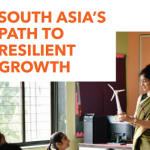The following is an excerpt from the chapter titled ‘Fostering Regional Trade Integration between South Asia and East Asia for COVID-19 Recovery’ – written by Dr. Ganeshan Wignaraja– which appeared in the book, ‘South Asia’s Path to Resilient Growth’ edited by Ranil Salgado and Rahul Anand, published by International Monetary Fund.
Since the 1990s, South Asia–East Asia trade and free trade agreements have accelerated as India’s trade realigned toward East Asia. As regional trade recovers after the COVID-19 pandemic, South Asian economies have opportunities to participate in global value chains and services trade. Regional trade integration across Asia can be encouraged by gradually reducing barriers to goods and services trade and investing in modern special economic zones, supported with adjustment financing and technical assistance to losing sectors to reallocate factors of production. Pursuing comprehensive free trade agreements eventually leading to the Regional Comprehensive Economic Partnership can provide for regional rules-based trade to help insure against rising protectionist tendencies. A reinvented trade-focused Bay of Bengal Initiative for Multi-Sectoral Technical and Economic Cooperation (BIMSTEC) may catalyze more effective regional cooperation for small and large economies alike. Narrower geographical coverage between South Asian and Southeast Asian economies could act as a building block for eventual trade integration across Asia. To avoid potential backlash against regionalization, special attention should also be paid to ensuring actual gains from trade for South Asia’s smaller and poorer economies.
Dr. Ganeshan Wignaraja is Professorial Fellow for Economics & Trade at Gateway House.
For more information regarding this book, click here.


